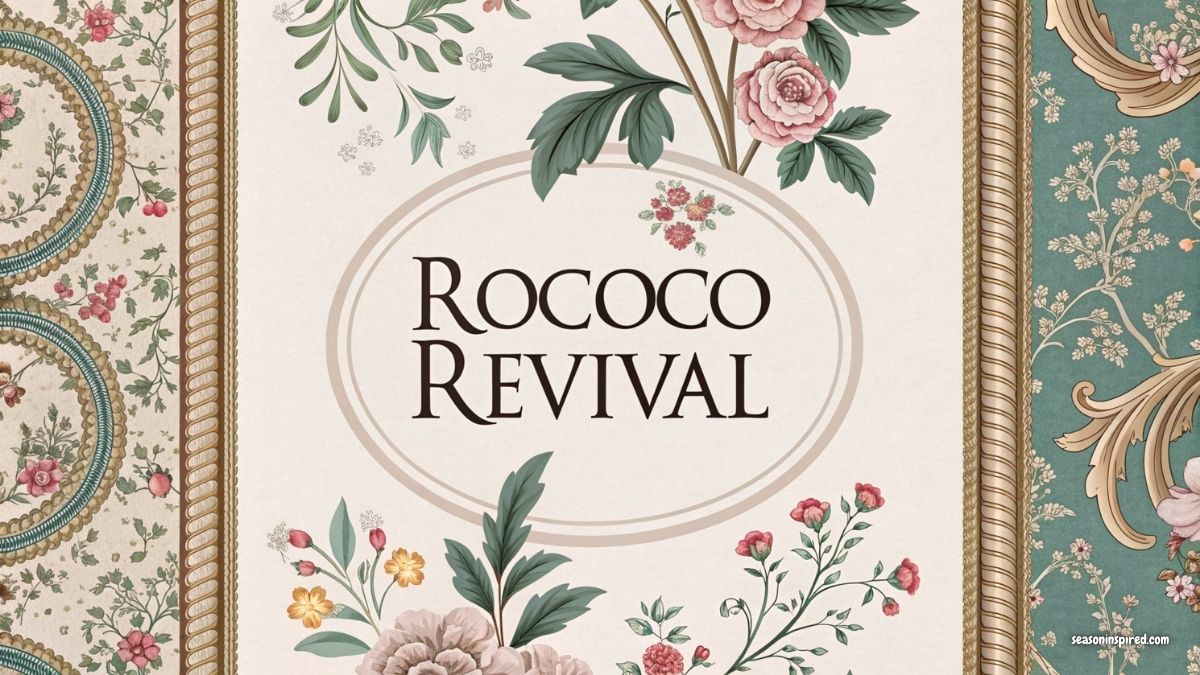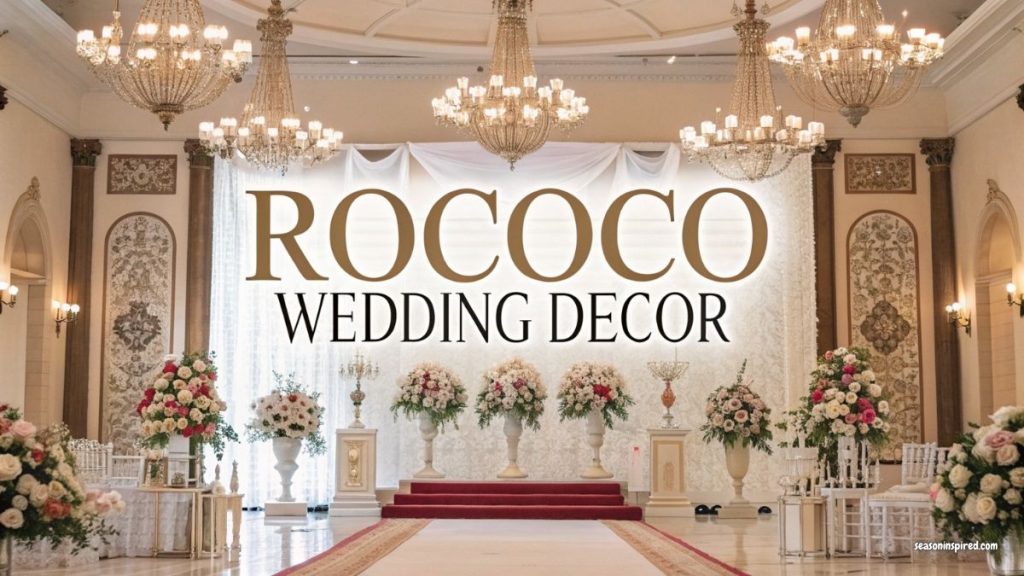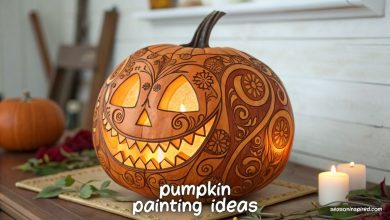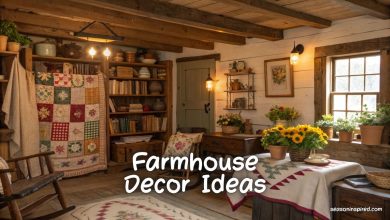Beyond the Powdered Wig: Why the Rococo Revival is the Soulful Cure for Your Minimalist Fatigue

Take a moment and look around your living room. Now, scroll through your favorite design feed. Do you see it? The endless sea of clean lines, neutral palettes, and a quiet, almost sterile perfection. For years, minimalism has reigned supreme. But what if your soul is craving… more? Not more clutter, but more story, more romance, more enchantment. This deep yearning for personality is the heart of the modern Rococo Revival, a glorious return to the playful opulence of 18th-century French interior design. Forget the dusty history books; this is about breathing life, charm, and a touch of rebellious romance back into our homes. In this guide, we’ll journey past the clichés and show you how to master Rococo style interior design for today—from curating the perfect soft pastel color palette aesthetic to finding that one-of-a-kind ornate vintage mirror that will transform your space from a mere house into a home with a heartbeat.
The Soul of Rococo: Understanding its Playful Spirit (And How It Differs from Baroque)
Before you hang a single crystal chandelier or unfurl a yard of silk damask, you must first understand that Rococo is not a set of rules, but a feeling. It is the architectural equivalent of a sigh of relief after a long, formal ceremony. Born in the salons of 18th-century French interior design, Rococo was a deliberate turn away from the heavy, imposing grandeur that came before it. It is the sound of whispered secrets, not royal decrees. It is the charm of a sun-drenched afternoon in a private garden, not the intimidating scale of a grand palace hall.
At its heart, the modern Rococo Revival celebrates these core principles:
- Lightness & Intimacy: Spaces were designed for conversation, music, and romance. Think smaller rooms, lower ceilings, and a focus on human-scale comfort.
- A Love Affair with Nature: Rococo design is obsessed with the organic forms of the natural world. Look for motifs of scrolling vines, delicate flowers, and seashells (the French word rocaille, meaning rock or shell, is the style’s very namesake).
- Asymmetry is Beautiful: Nature abhors a perfect straight line, and so does Rococo. Designs feel dynamic and alive, with C-scrolls and S-curves that dance across furniture and walls, creating a sense of graceful movement.
The Elegant Duel: Rococo vs. Baroque
It’s the most common point of confusion in historical design, but the difference is all about attitude. While both styles love opulence, their personalities are worlds apart.
Think of it this way:
- Baroque design is the grand, thundering symphony. It is Michelangelo’s St. Peter’s Basilica or the Hall of Mirrors at Versailles. It’s all about power, drama, intense emotion, deep colors (burgundy, forest green, royal blue), and rigid symmetry to express divine authority and absolute monarchy. It is designed to awe you into submission.
- Rococo design is the light, playful sonata. It is Madame de Pompadour’s private salon. It’s about charm, intimacy, leisure, and earthly pleasures. It uses a lighter palette, asymmetrical flourishes, and natural motifs to create a space that is comfortable, enchanting, and designed for human connection. It is designed to charm you into staying.
Baroque is a lion’s roar; Rococo is a witty whisper. Understanding this distinction is the key to capturing the true spirit of the style in your own home.
The Signature Rococo Color Palette: Whispers of Pastel and Gold
To step into a Rococo room is to be enveloped in a cloud of confectionary color. The palette is intentionally soft and luminous, designed to be illuminated by candlelight and reflect the sun pouring through tall French windows. Forget stark whites and moody grays; this is a soft pastel color palette aesthetic that feels both romantic and incredibly sophisticated.
Imagine the delicate blush on a porcelain doll’s cheek, the inside of an iridescent seashell, or the frosted sugar on a perfect macaron. These are your guiding stars.
The Foundational Hues
Build your palette around these quintessential Rococo shades:
- The Heavenly Blues & Greens: Think Serenity Blue, Duck Egg, Celadon, and soft Seafoam Green. These colors evoke a sense of calm and airy openness.
- The Romantic Pinks & Creams: Look for Petal Pink, Rosewater, Peach, and warm shades of Ivory and Cream. These hues create an intimate, flattering glow.
- The Sun-Kissed Neutrals: Don’t overlook the power of a sophisticated neutral base. Gentle Dove Gray, Antique White, and buttery yellows provide a perfect canvas for more colorful details.
The Midas Touch: The Essential Role of Gilded Accents
A Rococo palette is incomplete without its most crucial element: gold. Gilded accents home decor is not just an accessory; it is the thread that weaves the entire vision together. It’s the sparkle of champagne, the warmth of the sun. Gold is used to highlight the exquisite carvings on a mirror frame, the delicate legs of a console table, or the scrolling details of a wall sconce. It catches the light and makes the soft pastels sing, preventing them from ever feeling childish.
A Practical Guide to the Rococo Palette:
- Follow the 80/20 Principle: Let about 80% of your space be dominated by soft pastels and creams. Reserve the remaining 20% for the brilliant punctuation of gilded accents. This ensures a look that is elegant, not gaudy.
- Layer Your Tones: Don’t just paint a room a single shade of pink. Use a slightly deeper rose for velvet curtains, a paler petal pink on the walls, and ivory for the trim. This tonal layering creates depth and visual interest.
- A Modern Twist: To keep your Rococo Revival feeling fresh, ground the airy palette with one or two small, unexpected touches of a deeper color—a single velvet cushion in emerald green or a decorative vase in sapphire blue can add a contemporary edge.
Essential Rococo Furniture: Curves, Comfort, and Craftsmanship
In the world of Rococo, furniture is never merely functional; it is sculpture meant for living. Each piece is an invitation to recline, to converse, and to admire. The defining characteristic of Rococo furniture is its complete rejection of the straight line in favor of the graceful, organic curve. This is where the soul of the style truly takes physical form.
The Law of the Curve: Signature Silhouettes
As you begin your search for the perfect pieces, train your eye to spot these iconic forms:
- The Cabriole Leg: This is the undisputed star of Rococo furniture. Inspired by the shape of an animal’s leg, it curves outward at the “knee” and tapers inward at the “ankle,” often ending in a delicate scroll or foot. It gives even the heaviest pieces a sense of lightness and grace, as if they are about to dance.
- The Bombe Chest: The French word for “bombed” or bulging, this describes a commode (chest of drawers) that swells outward in a continuous, voluptuous curve on the front and sides. It is a statement piece of pure opulence.
- The Serpentine Front: A more subtle S-shaped curve often found on the front of desks, cabinets, and tables, adding a gentle sense of movement and rhythm.
Iconic Pieces for Your Modern Salon
You don’t need a full museum-quality set. Introducing just one or two of these archetypal pieces can infuse your entire room with the spirit of Rococo style interior design.
- The Bergère: A deep, wide armchair with upholstered sides and back, and a separate seat cushion. It is designed for luxurious lounging—the 18th-century equivalent of the perfect armchair to curl up in with a book.
- The Fauteuil: A more formal armchair with an open frame and padded armrests. It’s elegant and light, perfect for flanking a fireplace or as sophisticated dining chairs.
- The Canapé: The Rococo sofa is a masterpiece of carved wood and elegant upholstery, often featuring S-shaped curves and a beautifully sculpted back.
- The Console Table: A narrow table designed to be placed against a wall, almost always beneath a grand mirror. Its slender, ornate legs are a showcase for the carver’s art.
Modern Tip: The true secret to the modern Rococo Revival is mixing. Pair a magnificent vintage Bergère chair, reupholstered in a bold modern fabric, with your clean-lined contemporary sofa. The contrast is electric and deeply personal.
Gilded Accents & Ornate Details: The Jewels of Rococo Decor
If the furniture is the body of Rococo design, the decorative details are its soul-stirring jewelry. This is where the magic, shimmer, and personality truly come alive. These elements are not afterthoughts; they are essential characters in the story of your room.
The Power of Reflection: The Ornate Vintage Mirror
There is no single object more emblematic of Rococo decor than an ornate vintage mirror. It is the crown jewel of any room. More than just a reflective surface, it is a piece of art that magnifies light, creates the illusion of space, and serves as a breathtaking focal point. Look for frames with elaborate cartouches (ornamental crests) at the top, intertwined with carvings of flowers, leaves, and C-scrolls. A beautifully aged, water-gilded finish adds a layer of history and warmth that cannot be replicated.
Lighting as Atmosphere
Forget recessed spotlights. Rococo lighting is about creating a romantic, flattering glow.
- Crystal Chandeliers: The centerpiece of the ceiling, dripping with crystals that refract candlelight and sunlight into a thousand tiny rainbows.
- Gilded Sconces: Wall-mounted lights, often shaped like scrolling branches or ribbons, that provide soft pools of ambient light and add architectural interest to a plain wall.
Luxurious Textiles and Textures
The tactile experience is paramount. Drape your space in fabrics that beg to be touched:
- Silk Damask & Brocade: These rich, patterned silks are perfect for curtains and upholstery, adding a subtle shimmer and historical weight.
- Velvet: Use it on accent chairs or cushions for a touch of deep, plush comfort.
- Chinoiserie: This European interpretation of Chinese and East Asian artistic traditions was a Rococo obsession. Look for fabrics and wallpapers with whimsical scenes of pagodas, dragons, and exotic birds.
Bringing Rococo to Life: Room by Room Inspiration
Applying these principles is about creating a mood, not a museum. Here’s how to translate the Rococo spirit into the key areas of your Rococo house.
The Rococo Living Room: A Salon for Modern Conversation
Your living room should be an elegant stage for connection. Anchor the space with a stunning canapé and a pair of comfortable armchairs arranged to encourage conversation. An ornate vintage mirror hung above a fireplace or console table will serve as the undeniable focal point. Keep the flow open and graceful—this isn’t about stuffing a room with furniture, but about curating beautiful, functional pieces that invite people to gather.
The Rococo Bedroom: Your Personal Boudoir
This is your sanctuary, the space where you can lean fully into romance and fantasy.
- The Bed is the Star: Choose a headboard with deep button-tufting or an elegantly carved and gilded frame.
- Create Softness Everywhere: Think silk curtains that pool gently on the floor, a plush area rug over hardwood floors, and a small chaise lounge in a corner for reading.
- Flattering Light: Forgo harsh overhead lighting in favor of delicate sconces on either side of the bed and a small, sparkling chandelier in the center of the room.
Beyond the Home: Embracing the Rococo Aesthetic in Your Life
Rococo is more than an interior style; it’s a philosophy of appreciating beauty, romance, and artistry in all facets of life.
Fashion and the “Old Money Aesthetic”
The principles of Rococo—quality craftsmanship, timeless elegance, and a certain romantic flair—are echoed in the modern old money aesthetic outfit. It’s about investing in beautiful, well-made pieces: a silk blouse with delicate ruffled cuffs, a string of classic pearls, fabrics like cashmere and tweed. It’s a quiet luxury that whispers, rather than shouts.
The Art of Rococo Makeup
Translate the soft pastel palette to your beauty routine. Rococo makeup is all about a luminous, ethereal glow. Think cherubic, flushed cheeks with a cream blush, soft pink lips, highlighted cheekbones, and bright, doe-like eyes. It’s a look of health, romance, and delicate artistry.
A Dream Come True: Rococo Wedding Decor

For the ultimate romantic celebration, nothing compares to a Rococo theme. Imagine invitations with flowing calligraphy, tablescapes overflowing with pastel roses and peonies, gilded charger plates, antique silverware, and an atmosphere bathed in the warm, flickering glow of hundreds of candles. It’s an aesthetic that turns a special day into a true fairytale.
Your First Step: Creating a Modern Rococo Moodboard
Feeling inspired? It’s time to channel that excitement into a concrete plan. A Rococo moodboard is your most powerful tool for translating this grand vision into a personal, achievable reality.
- Gather Your Inspiration: Go beyond a simple Pinterest board. Tear pages from magazines, screenshot scenes from films (like Sofia Coppola’s Marie Antoinette), and take photos of details you love—the curve of a chair leg in an antique shop, the color of a sunset.
- Pinpoint the Essentials: As you collect images, ensure you capture the core elements:
- Colors: Your specific shades of pastel pink, blue, cream, and gold.
- Silhouettes: The furniture shapes that make your heart sing.
- Motifs: Close-ups of shell carvings, floral patterns, and scrollwork.
- Textures: Swatches of silk, velvet, aged gold leaf, and polished wood.
- Lighting: The chandeliers and sconces that define your dream ambiance.
- Refine Your Vision: Look at your completed board. What story does it tell? Is your personal take on the Rococo Revival light, airy, and minimalist? Or is it opulent, layered, and dramatic? This board is now your blueprint, the visual guide that will keep you focused as you begin the thrilling hunt for each perfect piece.
See Also: 15 Recipes to Make Your House Smell Like Your Best Fall Memory
Wrapping Up
The Rococo Revival is more than just a fleeting trend; it’s a heartfelt rebellion against the impersonal. It’s permission to embrace the beautiful, the ornate, and the wonderfully whimsical. You’ve seen how incorporating gilded accents home decor or a piece of Rococo furniture isn’t about creating a historical diorama, but about telling your own story with a vocabulary of timeless romance and elegance. Your home doesn’t have to look like a catalog. It can be a sanctuary of soft light, enchanting details, and personal history. You now have the vision to step away from the beige and begin crafting your own Versailles-inspired dream, one beautiful detail at a time.
Find one small way to introduce a Rococo element into your life this week. Perhaps it’s a single, ornate teacup or a velvet ribbon. Share this post with a friend who appreciates the art of living beautifully!



